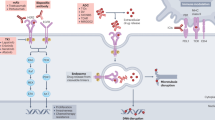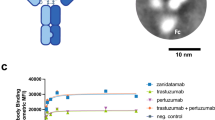Abstract
Cytokeratin19 (KRT19) is widely used as a biomarker for the detection of disseminated tumors. Using an LC-MS/MS proteomics approach, we found that KRT19 was upregulated in HER2-overexpressing cells and tissues. KRT19 expression was induced by HER2-downstream ERK at the transcriptional level. Another HER2-downstream kinase, Akt, was found to phosphorylate KRT19 on Ser35 and induce membrane translocation of KRT19 and remodeling of KRT19 from filamentous to granulous form. KRT19 phosphorylated by Akt could bind HER2 on the plasma membrane and stabilized HER2 via inhibition of proteasome-mediated degradation of HER2. Silencing of KRT19 by shRNA resulted in increased ubiquitination and destabilization of HER2. Moreover, treatment of KRT19 antibody resulted in downregulation of HER2 and reduced cell viability. These data provide a new rationale for targeting HER2-positive breast cancers.
Similar content being viewed by others
Log in or create a free account to read this content
Gain free access to this article, as well as selected content from this journal and more on nature.com
or
Abbreviations
- KRTs:
-
cytokeratins
- KRT19:
-
cytokeratin19
- ERK:
-
extracellular signal-regulated protein kinase
- WT:
-
wild type
- TG:
-
transgenic
- HA-Akt1-CA:
-
constitutively active Akt1
- HA-Akt1-KD:
-
kinase-dead Akt1
- HER2-FL-myc:
-
full-length HER2
- HER2-ICD-myc:
-
intracellular HER2
- HER2-ECD-myc:
-
extracellular HER2
- CHX:
-
cycloheximide
- VEGF:
-
vascular endothelial growth factor
References
Slamon DJ, Clark GM, Wong SG, Levin WJ, Ullrich A, McGuire WL . Human breast cancer: correlation of relapse and survival with amplification of the HER-2/neu oncogene. Science 1987; 235: 177–182.
Tzahar E, Waterman H, Chen X, Levkowitz G, Karunagaran D, Lavi S et al. A hierarchical network of interreceptor interactions determines signal transduction by Neu differentiation factor/neuregulin and epidermal growth factor. Mol Cell Biol 1996; 16: 5276–5287.
Karunagaran D, Tzahar E, Beerli RR, Chen X, Graus-Porta D, Ratzkin BJ et al. ErbB-2 is a common auxiliary subunit of NDF and EGF receptors: implications for breast cancer. EMBO J 1996; 15: 254–264.
Neve RM, Sutterluty H, Pullen N, Lane HA, Daly JM, Krek W et al. Effects of oncogenic ErbB2 on G1 cell cycle regulators in breast tumour cells. Oncogene 2000; 19: 1647–1656.
Munster PN, Marchion DC, Basso AD, Rosen N . Degradation of HER2 by ansamycins induces growth arrest and apoptosis in cells with HER2 overexpression via a HER3, phosphatidylinositol 3'-kinase-AKT-dependent pathway. Cancer Res 2002; 62: 3132–3137.
Manning BD, Cantley LC . AKT/PKB signaling: navigating downstream. Cell 2007; 129: 1261–1274.
Alessi DR, Caudwell FB, Andjelkovic M, Hemmings BA, Cohen P . Molecular basis for the substrate specificity of protein kinase B; comparison with MAPKAP kinase-1 and p70 S6 kinase. FEBS Lett 1996; 399: 333–338.
Gonzalez FA, Seth A, Raden DL, Bowman DS, Fay FS, Davis RJ . Serum-induced translocation of mitogen-activated protein kinase to the cell surface ruffling membrane and the nucleus. J Cell Biol 1993; 122: 1089–1101.
Marais R, Wynne J, Treisman R . The SRF accessory protein Elk-1 contains a growth factor-regulated transcriptional activation domain. Cell 1993; 73: 381–393.
Okazaki K, Sagata N . The Mos/MAP kinase pathway stabilizes c-Fos by phosphorylation and augments its transforming activity in NIH 3T3 cells. EMBO J 1995; 14: 5048–5059.
Milanini-Mongiat J, Pouyssegur J, Pages G . Identification of two Sp1 phosphorylation sites for p42/p44 mitogen-activated protein kinases: their implication in vascular endothelial growth factor gene transcription. J Biol Chem 2002; 277: 20631–20639.
Plowman JE . The proteomics of keratin proteins. J Chromatogr B Analyt Technol Biomed Life Sci 2007; 849: 181–189.
Coulombe PA, Wong P . Cytoplasmic intermediate filaments revealed as dynamic and multipurpose scaffolds. Nat Cell Biol 2004; 6: 699–706.
Wu YJ, Rheinwald JG . A new small (40 kd) keratin filament protein made by some cultured human squamous cell carcinomas. Cell 1981; 25: 627–635.
Bader BL, Magin TM, Hatzfeld M, Franke WW . Amino acid sequence and gene organization of cytokeratin no. 19, an exceptional tail-less intermediate filament protein. EMBO J 1986; 5: 1865–1875.
Ignatiadis M, Xenidis N, Perraki M, Apostolaki S, Politaki E, Kafousi M et al. Different prognostic value of cytokeratin-19 mRNA positive circulating tumor cells according to estrogen receptor and HER2 status in early-stage breast cancer. J Clin Oncol 2007; 25: 5194–5202.
Bozionellou V, Mavroudis D, Perraki M, Papadopoulos S, Apostolaki S, Stathopoulos E et al. Trastuzumab administration can effectively target chemotherapy-resistant cytokeratin-19 messenger RNA-positive tumor cells in the peripheral blood and bone marrow of patients with breast cancer. Clin Cancer Res 2004; 10: 8185–8194.
Xenidis N, Vlachonikolis I, Mavroudis D, Perraki M, Stathopoulou A, Malamos N et al. Peripheral blood circulating cytokeratin-19 mRNA-positive cells after the completion of adjuvant chemotherapy in patients with operable breast cancer. Ann Oncol 2003; 14: 849–855.
Park S, Lee KM, Ju JH, Kim J, Noh DY, Lee T et al. Protein expression profiling of primary mammary epithelial cells derived from MMTV-neu mice revealed that HER2/NEU-driven changes in protein expression are functionally clustered. IUBMB Life 2010; 62: 41–50.
Brembeck FH, Rustgi AK . The tissue-dependent keratin 19 gene transcription is regulated by GKLF/KLF4 and Sp1. J Biol Chem 2000; 275: 28230–28239.
Johnson JL, Pacquelet S, Lane WS, Eam B, Catz SD . Akt regulates the subcellular localization of the Rab27a-binding protein JFC1 by phosphorylation. Traffic 2005; 6: 667–681.
Basu S, Totty NF, Irwin MS, Sudol M, Downward J . Akt phosphorylates the Yes-associated protein, YAP, to induce interaction with 14-3-3 and attenuation of p73-mediated apoptosis. Mol Cell 2003; 11: 11–23.
Fang D, Hawke D, Zheng Y, Xia Y, Meisenhelder J, Nika H et al. Phosphorylation of beta-catenin by AKT promotes beta-catenin transcriptional activity. J Biol Chem 2007; 282: 11221–11229.
Hoyal CR, Gutierrez A, Young BM, Catz SD, Lin JH, Tsichlis PN et al. Modulation of p47PHOX activity by site-specific phosphorylation: Akt-dependent activation of the NADPH oxidase. Proc Natl Acad Sci USA 2003; 100: 5130–5135.
Zhang H, Zha X, Tan Y, Hornbeck PV, Mastrangelo AJ, Alessi DR et al. Phosphoprotein analysis using antibodies broadly reactive against phosphorylated motifs. J Biol Chem 2002; 277: 39379–39387.
Zhang DH, Tai LK, Wong LL, Sethi SK, Koay ES . Proteomics of breast cancer: enhanced expression of cytokeratin19 in human epidermal growth factor receptor type 2 positive breast tumors. Proteomics 2005; 5: 1797–1805.
Milanini J, Vinals F, Pouyssegur J, Pages G . p42/p44 MAP kinase module plays a key role in the transcriptional regulation of the vascular endothelial growth factor gene in fibroblasts. J Biol Chem 1998; 273: 18165–18172.
Benasciutti E, Pages G, Kenzior O, Folk W, Blasi F, Crippa MP . MAPK and JNK transduction pathways can phosphorylate Sp1 to activate the uPA minimal promoter element and endogenous gene transcription. Blood 2004; 104: 256–262.
Omary MB, Ku NO, Tao GZ, Toivola DM, Liao J . "Heads and tails" of intermediate filament phosphorylation: multiple sites and functional insights. Trends Biochem Sci 2006; 31: 383–394.
Zhou X, Liao J, Hu L, Feng L, Omary MB . Characterization of the major physiologic phosphorylation site of human keratin 19 and its role in filament organization. J Biol Chem 1999; 274: 12861–12866.
Fortier AM, Van Themsche C, Asselin E, Cadrin M . Akt isoforms regulate intermediate filament protein levels in epithelial carcinoma cells. FEBS Lett 2010; 584: 984–988.
Strnad P, Windoffer R, Leube RE . Induction of rapid and reversible cytokeratin filament network remodeling by inhibition of tyrosine phosphatases. J Cell Sci 2002; 115: 4133–4148.
Woll S, Windoffer R, Leube RE . p38 MAPK-dependent shaping of the keratin cytoskeleton in cultured cells. J Cell Biol 2007; 177: 795–807.
Ku NO, Omary MB . Identification of the major physiologic phosphorylation site of human keratin 18: potential kinases and a role in filament reorganization. J Cell Biol 1994; 127: 161–171.
Alix-Panabieres C, Vendrell JP, Slijper M, Pelle O, Barbotte E, Mercier G et al. Full-length cytokeratin-19 is released by human tumor cells: a potential role in metastatic progression of breast cancer. Breast Cancer Res 2009; 11: R39.
Nagy P, Friedlander E, Tanner M, Kapanen AI, Carraway KL, Isola J et al. Decreased accessibility and lack of activation of ErbB2 in JIMT-1, a herceptin-resistant, MUC4-expressing breast cancer cell line. Cancer Res 2005; 65: 473–482.
Ju JH, Yang W, Lee KM, Oh S, Nam K, Shim S et al. Regulation of cell proliferation and migration by keratin19-induced nuclear import of early growth response-1 in breast cancer cells. Clin Cancer Res 2013; 19: 4335–4346.
Kurokawa H, Lenferink AE, Simpson JF, Pisacane PI, Sliwkowski MX, Forbes JT et al. Inhibition of HER2/neu (erbB-2) and mitogen-activated protein kinases enhances tamoxifen action against HER2-overexpressing, tamoxifen-resistant breast cancer cells. Cancer Res 2000; 60: 5887–5894.
Griffin NM, Yu J, Long F, Oh P, Shore S, Li Y et al. Label-free, normalized quantification of complex mass spectrometry data for proteomic analysis. Nat Biotechnol 2010; 28: 83–89.
Abbott DW, Holt JT . Mitogen-activated protein kinase kinase 2 activation is essential for progression through the G2/M checkpoint arrest in cells exposed to ionizing radiation. J Biol Chem 1999; 274: 2732–2742.
Shin I, Yakes FM, Rojo F, Shin NY, Bakin AV, Baselga J et al. PKB/Akt mediates cell-cycle progression by phosphorylation of p27(Kip1) at threonine 157 and modulation of its cellular localization. Nat Med 2002; 8: 1145–1152.
Stathopoulou A, Gizi A, Perraki M, Apostolaki S, Malamos N, Mavroudis D et al. Real-time quantification of CK-19 mRNA-positive cells in peripheral blood of breast cancer patients using the lightcycler system. Clin Cancer Res 2003; 9: 5145–5151.
Roychowdhury S, Vyas PM, Reilly TP, Gaspari AA, Svensson CK . Characterization of the formation and localization of sulfamethoxazole and dapsone-associated drug-protein adducts in human epidermal keratinocytes. J Pharmacol Exp Ther 2005; 314: 43–52.
Wu X, Gan B, Yoo Y, Guan JL . FAK-mediated src phosphorylation of endophilin A2 inhibits endocytosis of MT1-MMP and promotes ECM degradation. Dev Cell 2005; 9: 185–196.
Yokoyama WM . Production of monoclonal antibody supernatant and ascites fluid. Curr Protoc Mol Biol 2008; Chapter 11: Unit 11 10.
Acknowledgements
This work was supported by NRF grant (2013-059143) from the Korea Research Foundation and the Converging Research Center Program funded by Ministry of Science, ICT & Future Planning (Project No. 2014048814). We thank Dr. Omary (Stanford University), Dr. Rustgi (Univ of Pennsylvania) and Dr. Su-Jae Lee for the plasmid constructs.
Author information
Authors and Affiliations
Corresponding author
Ethics declarations
Competing interests
The authors declare no conflict of interest.
Additional information
Edited by JP Medema
Supplementary Information accompanies this paper on Cell Death and Differentiation website
Supplementary information
Rights and permissions
About this article
Cite this article
Ju, Jh., Oh, S., Lee, Km. et al. Cytokeratin19 induced by HER2/ERK binds and stabilizes HER2 on cell membranes. Cell Death Differ 22, 665–676 (2015). https://doi.org/10.1038/cdd.2014.155
Received:
Revised:
Accepted:
Published:
Issue date:
DOI: https://doi.org/10.1038/cdd.2014.155
This article is cited by
-
Keratin 19 regulates cell cycle pathway and sensitivity of breast cancer cells to CDK inhibitors
Scientific Reports (2019)
-
Microfluidic cell sorting by stiffness to examine heterogenic responses of cancer cells to chemotherapy
Cell Death & Disease (2018)
-
KRT19 directly interacts with β-catenin/RAC1 complex to regulate NUMB-dependent NOTCH signaling pathway and breast cancer properties
Oncogene (2017)



